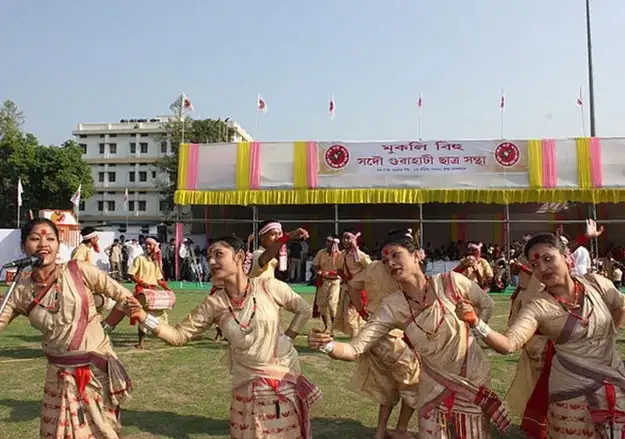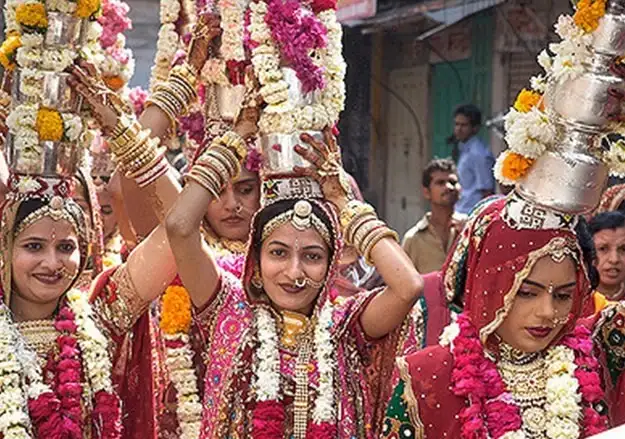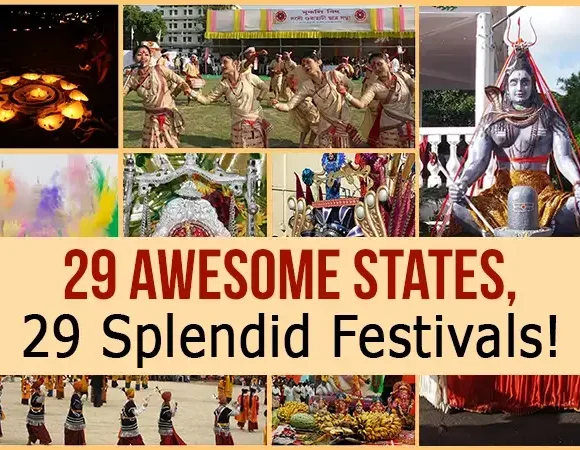29 Awesome States, 29 Splendid Festivals

29 Awesome States, 29 Splendid Festivals
Fairs and festivals add much needed zing to our life and give us an opportunity to forget all our tensions and make merry. They are the very essence of our vibrant culture. India being a melting pot of several religions has no dearth of festivals to celebrate. Here is a rundown on the festivals which define the 29 states of India
1. Andhra Pradesh — Brahmotsavam

The most important and auspicious annual fête celebrated at Sri Venkateswara Temple in Tirupati in Andhra Pradesh. Sri Venkateswara Swami Vari Brahmotsavam is conducted for nine days during the months September — October.
The Utsava-murti (processional deity) of the Lord Venkateswara, along with his consorts Sridevi and Bhudevi, will be taken on a procession on different Vahanams on the streets surrounding the temple.
This attracts pilgrims and tourists from all parts of India and abroad. Popular legend says that Brahma, the creator God worshiped Venkateswara on the banks of the holy Swami Pushkarini in Tirupati as a way to give thanks for the Lord’s protection of mankind.
2. Arunachal Pradesh — Losar Festival

The Tibetan New year is also known as Losar and is mainly celebrated for 3 days in late January or February. Marked with ancient ceremonies that represent the struggle between good and evil Lossar has people chanting and passing fire torches through the crowds.
Events like the dance of the deer and the amusing battles between the King and his various ministers provide the cheerful side of festivities. Losar Festival is characterized especially by dancing, music, and a general spirit of merry making.
3. Assam — Bohag Bihu

It’s the time to greet each other a Happy New Year! The spring festival of Bohaag Bihu or Rongali Bihu ushers in the New Year in the State of Assam, which marks the onset of a new agricultural cycle. Many fairs are organized where people revel in festivities and visit each other’s houses, exchange gifts.
Young girls in traditional attire sing “Bihugeets” and dance the traditional “MukoliBihu”. The celebrations go on for days together, and it’s also a good time for young people to find a companion of their own choice!
4. Bihar — Chhath Puja

Chhath Puja also called Dala Puja devoted to worshiping the sun is traditionally celebrated by the people of Bihar. Chhath falls in the months of October or November.
Chhath assumes a joyous and colorful form as people dress up in their best clothes and gather by rivers and other water bodies to celebrate. Lamps are lit and devotional folk songs sung in honor of ‘Chhat Maiya’ or Ganga. After sunset earthen lamps or ‘diyas’ are lit in the courtyards of houses.
5. Chattisgarh — Bastar Dussehra

Bastar Dussehra the longest Dussehra celebrations in the world is celebrated in Bastar and spans over 75 days starting around August and ending at October. Diverse tribes participate with traditional customs.
Bastar Dussehra begins with several customs like ‘Pata jatra’, or worship of wood followed by ‘Deri Gadhai’- Posting of the pillars, Kachan Gaadi- Throne for goddess Kachan Devi, Kalash Sthapana- Installation of urns, Jogi Bithai- Jogi’s penance, Rath Parikrama- The chariot circuit, Nisha Jatra- The nocturnal festival, Jogi Uthai- Raising of the jogi, Maoli Parghav- Reception of Devi Maoli, Bheetar Raini- The inner circuit, Baahar Raini- The outer circuit, Kachan Jatra- Thanksgiving ceremony, Muria Durbar- The tribal chieftains’ conference and finally on the last day, Ohadi- A farewell to deities.
6. Goa — Carnival

The exciting and fun-filled three-day non-stop extravaganza of fun, frolic, song, music and dance that is uniquely Goan! Celebrated since the 18th century, it was meant to be a feasting-drinking-merrymaking orgy just before the 40 days of Lent; a time of abstinence and spirituality.
In the Carnival huge parades through the cities are organized with bands, floats and dances and balls in the evenings. The final day concludes with the famous Red-and-Black dance held by the Clube Nacional in Panjim.
The carnival is presided over by King Momo, who on the opening day orders his subjects to party. The festival attracts thousands of tourists.
7. Gujarat — Janmashtami, Diwali

The birth anniversary of Lord Krishna is celebrated with great fervor all over India especially at Gujarat. Temples and homes are beautifully decorated and lit. People fast all day and eat only after the midnight birth ceremony.
Mathura has many temples dedicated to Krishna where night long prayers are offered and religious hymns are sung.Often, small children dress up like Lord Krishna on this day. In the temples, images and picturization of Krishna’s life story are depicted.
The festival of lights Diwali is also celebrated with much enthusiasm in Gujarat. Lamps are lit in all houses and sweets are distributed by people. Festival marks the beginning of the New Year.
8. Haryana — Baisakhi

Festival of Baisakhi marks the time for harvest of Rabi crops and farmers celebrate it with lots of joy and zeal in Punjab and Haryana. The day of Baisakhi dawns in colors and vibrancy as cries of “Jatta aayi Baisakhi” reverberate in the skies as gaily-dressed men and women move towards the fields to celebrate the occasion.
The traditional folk dances Bhangra and Gidda are performed by men and women to the beat of Dhol. Colourful Baisakhi Fairs are also organized to celebrate the day. Wrestling bouts, singing and acrobatics are held along with music performances.
9. Himachal Pradesh — Mahashivaratri

Himachal Pradesh is said to host the biggest Shivaratri celebration in the country. A week-long international Mandi Shivratri Fair is held near the Temple of Bhoothnath (Lord Shiva) every year and it attracts a lot of tourists from all over the country and even abroad.
Every year a Shobha Yatra is conducted which witnesses unmatched fervor and utmost participation. The entire night during Shivratri celebration reverberates with exalted spiritual energy. A combination of five pure ingredients comprising milk, butter, curd, honey and sugar is offered to Lord Shiva.
10. Jammu and Kashmir — Eid-ul-Fitr and Eid-ul-Azha

If you have to experience the real fun and celebrations of Id, you have to be in Kashmir! Eid-ul-Fitr marks the end of fasting month of Ramadan. On this day, Muslims wear new clothes and attend many grand feasts. Eid-ul-Azha is an equally important festival, which is more prominent for the Qurbani (sacrifice). People sacrifice goats, sheep and some even camels.
On this day, Muslims show their real joy for the health, strength and the opportunities of life, which Allah has given to them to fulfill their obligation of fasting and other good deeds during the blessed month of Ramadan.
11. Jharkhand — Holi

Holi is celebrated in the months of February/March with great charm and vigor The spring festival of Holi is one of the most important festivals of Jharkhand. The lighting of bonfire also forms a special feature of the Holi celebrations in Dhanbad.
Fun and frolic are also redefined in various forms in the festive celebrations here. People greet each other with colors and thus enhance the feeling of harmony due to which happiness prevails. The tradition of playing Holi with mud is also extremely delightful.
12. Karnataka — Ugadi

People from all over Karnataka celebrate Ugadi in the second half of March or in early April with much enthusiasm and gaiety. Ugadi is considered as an auspicious time for commencing new ventures.
The popular legend is that the Lord Brahma started the creation of the vast universe on the auspicious day of Ugadi and it also marks the beginning of the new Hindu lunar calendar. People decorate their homes and puja rooms with flowers and mango leaves. Special dishes are prepared and enjoyed by the people to mark the festival.
13. Kerala — Onam

Onam is one of the popular festivals of Kerala is celebrated with joy and enthusiasm by people of all communities. According to a popular legend, the festival is celebrated to welcome King Mahabali, whose spirit is said to visit Kerala at the time of Onam. Intricately designed flower mats called, Pookalams are made in the front courtyard of the house to welcome King Mahabali.
Onam is celebrated in Chingam, (August-September) and lasts for ten days. The tenth day, Thiruonam is marked by elaborate feasts, folk songs, elegant dances, energetic games, elephants, boats and flowers. Vallamkali, the enchanting Snake Boat Race, Folk performances like Kummatti kali and Pulikali add to the zest of celebrations.
14. Madhya Pradesh — Diwali

Madhya Pradesh celebrates Diwali, the Festival of lights with much splendour. Decorations and lighting are done throughout houses & markets. Prior to the Diwali night, called the Dhan-teras all the shops remain open the whole night. Sweets are prepared in every household and exchanged.
On Diwali day, houses all over Madhya Pradesh glow with a twinkle of innumerable diyas, candles and electric lights. The night is illuminated with the flaming lights of fireworks. Diwali Festival marks the beginning of the New Year. The Baiga and Gond tribes performed their traditional dances to celebrate the Diwali Festival.
15. Maharashtra — Ganesh Chaturthi

Ganesh Chaturthi, the most important festival of Maharashtra falls in months of August — September. Ganesh images are kept in houses as a divine guest for five to ten days by people. The image is then taken out ceremoniously and immersed in the river, sea or well. It is called Visarjan. Modak is special cuisine for Ganesh Chaturthi celebrations.
Huge Ganesh idols are worshipped at nicely decorated pandals for 8 to 10 days. Slogans of Ganpathi Bappa Morya reverberate as the idols are taken out in huge processions during the day of immersion. Cultural activities of singing, dancing, and theater, and free medical and blood donation camps are held during the festival.
16. Manipur — Yaoshang

One of the premier festivals of Manipur, Yaoshang is celebrated for five days and commences from the full moon day of Phalguna (February/march). The main highlight of the festival is the Thabal Chongba dance, a Manipuri folk dance where boys and girls form a circle and hold hands and sing and dance.
Donations are collected from house to house and the money collected is spent on parties and merry making.So if you are planning a trip to Manipur in the month of February, don’t forget to be a part of the Yaoshang festival and carry home the memories you will cherish all your lives.
17. Meghalaya — Nongkrem Dance Festival

The Nongkrem dance festival of the hill state of Meghalaya is a five days long religious festival devoted to appease the Goddess Ka Blei Synshar for a rich bumper harvest and prosperity of the people.
Dances are performed by unmarried men & women dressed in exotic costumes. The men’s dancing is naturally more vigorous and energetic. They hold a sword in their right hand and usually a white Yak hair whisk in their left hand, keeping time to the changing beats of drums and playing of the tangmuri or pipes.
18. Mizoram — ChapcharKut Festival

Mizoram’s biggest festival, Chapchar Kut marks the clearing and readying of hill slopes for jhum or shifting cultivation. It is celebrated with gaiety and fervor by young & old.
On this day people dressed in colorful costumes and distinctive head gears and jewelries, assemble and perform various folk dances, singing traditional songs accompanied by beating of drums, gongs and cymbals. The energetic Bamboo dance&other main dances like Khuallam, Chheihlam, Chai and Sarlamkai are performed as part of community festivities.
Exhibition and sale of indigenous Handloom and Handicraft products and flower show, food festival, musical competition and different traditional games are also organized during the Chapchar Kut festival
19. Nagaland — Hornbill Festival

The week-long Hornbill Festival of Nagaland is one of the biggest cultural extravaganzas in the North East& held every year from Dec1–10. It is a festival to revive, protect, sustain, and promote the richness of the Naga heritage and traditions.
All the Naga tribes get together for a week-long celebration of their cultural and traditional plight and showcase their age-old traditions.
20. Odisha (Orissa) — Raja Parba

Raja Parba is the living cultural heritage of Odisha and the manifestation of the agricultural way of life. A festival of harvest held for three days in June, the first day is called Pahili Raja, the second day is the Raja Sankranti, and the third day is Basi Raja.
A joyous atmosphere pervades as the young men of the village play local games like Kabaddi. Competitions are also held between different groups of the village. A festival of joy you can say!
21. Punjab — Lohri

Lohri is a popular festival, celebrated by Punjabi particularly of Hindu and Sikh faith on the 13thof January a day before Makar Sankranti.
A week before Lohri, children begin gathering firewood and huge fires are burnt on Lohri night. In the morning, children go from door to door singing and demanding the Lohri ‘loot’ in the form of money and eatables. Lohri is essentially a festival dedicated to the Sun god and to share the warmth with your family and loved ones.
22. Rajasthan — Gangaur Festival

The Gangaur festival in Rajasthan is a colourful affair and offers a wonderful opportunity to tourists to enjoy cultural festivity.
It falls a fortnight after Holi&is celebrated for 18 days in honor of Goddess Parvati mostly by the womenfolk of Rajasthan. Offerings are made to the Goddess Parvati& the festival is considered an auspicious occasion for young people to choose their life partners.
During the festival, images of Gauri (the other name of Goddess Paravati) and Shiva are taken out in colorful processions. The whole event comes to an end with the display of wonderful fireworks.
23. Sikkim — Saga Dawa

The magnificent carnival of Sikkim, Saga Dawa is famous for masked dances and the festival exhibits in rare and elegant colors add richness and diversity. On the day of the Saga Dawa the people of Sikkim, especially the Mahayana Buddhists gather in temples and pay due honor to the Lord.
They light up lamps and the ceremony is followed by a grand pageant which consists of Monks who move to the chants of holy scriptures and hymns in the procession
24. Tamil Nadu — Pongal

Pongal is a four-day-long harvest festival of Tamil Nadu which falls in the month of January-February.
The first day of Pongal — The Bhogi festival is celebrated with the ritual of Bhogi Mantalu when useless items of the household are tossed into a bonfire traditionally made of cow dung cakes and wood. On the second day — Thai Pongal, rice and milk are boiled together in an earthen pot as an offering to the sun god.
Sugarcane, coconuts and bananas are also offered. The third day — Mattu Pongal is dedicated to cows. They are adorned with bells, sheaves of corn, garlandsand worshipped. The houses look magnificent with Kolam designs (traditional floral designs made with rice, colored powders, and flower petals).
25. Telangana — Bonalu

Bonalu is celebrated in Telangana and the word Bonalu came from “Bhojanalu” which is offered to the goddess during festival time. It is believed that the Goddess comes back to her maternal home on this day. So people come to see her and bring offerings of food (Bonalu).
Women prepare Bonam in a pot and decorate with small neem branches, turmeric, kumkum and a Lamp on the top of it. Women put the pots on their heads and take it to Goddess temple, led by drummers and dancing men.
26. Tripura — Kharchi Puja
Kharchi puja is the worship of the fourteen gods of Tripura and is celebrated in the month of July-August. On the day of puja, the fourteen deities are carried to river Saidra, bathed in the holy water and brought back to the temple.
People offer different type so Prasad like goat, buffalo, fouls, sweets etc. Nowadays many cultural programs are performed in the night and a large fair is also organized on the occasion.
27. Uttar Pradesh — Navaratri

Navratri is one of the holiest Hindu festivals is celebrated with much pomp and grandeur in Uttar Pradesh. Navratri is celebrated for nine nights during which people worship Goddess Durga and her nine forms to seek Her blessings.
Special pujas of Devi are also held by setting up the images/idols of Mother Durga in beautifully decorated pandals accompanied by cultural songs, dances, and dramas. These idols are then immersed in rivers at the end of the festival.
28. Uttarakhand — Ganga Dusshera

In the month of June, Ganga Dussehra is celebrated at major ghats of Uttarakhand. This festival is a day of devotion and faith. People in large numbers bathe in the Ganga to get purified of sins and at night devotees start offering leaf boats with flames, sweets and flowers to the river.
Big fairs are also organized in various parts of India like Varanasi, Haridwar, Mathura and Allahabad which are the major attractions during this time.
29. West Bengal — Durga Puja

Durga Puja also referred to as Durgotsava in West Bengal and celebrated with much gaiety and pomp here. The festival is commemorated by worshipping Goddess Durga. It is one of the biggest festivals in Bengal and is celebrated on a mass scale with Puja Pandals erected on almost every corner. Community Pujas are also organized in each locality.
On the last day, the idols are taken in decorative processions to be immersed in the river or the pond. Apart from traditional rituals, many cultural activities like song and dance competitions, games and fetes are organized during the festival.
India is a land of festivals where people of all religions coexist in harmony. The festivals are a true manifestation of its culture and traditions. Now that you have been through the festivals which define the 29 states of India it is up to you to celebrate them with all pomp and splendor.





